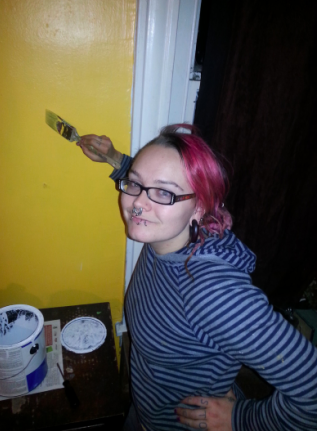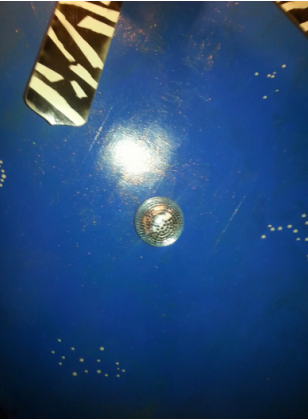|
The Breadcrumbs widget will appear here on the published site.
Time to Redecorate Your Cabin! About this time of year, if not earlier, I tend to get a sweet combination of the 'winter blues' and 'cabin fever.' Too little sunshine, too much cold and being stuck inside add up to make me depressed and antsy. One thing I do to fix this pretty much every year is paint some part of the inside of my house over the winter. Outdoor chores and tasks aren't always pleasant or even possible in cold temperatures. Most types of paint need it to be 50 degrees or higher when you apply them, so they just won't work in the colder months. But as long as your house is 50 degrees or warmer, and I hope for your sake it is, conditions are right for painting! Redecorating my space a little bit brightens it up. A fresh coat of paint covers up old smudges and smears, looks and is super clean, and also means you can rearrange all of your pictures and posters. The change of scenery inside is great when the scenery out your window is just grey and blah. I own my house, so that gives me free reign to do what I want, but you might be in a different circumstance. My advice to you is to check out your lease or agreements before you start slapping paint on the walls. It will probably be more depressing to find out you will not be getting your security deposit back. One year, I painted the walls of my kitchen pink, and then used stencils and gold spray paint to alternate between kitschy country lovebirds with hearts and an anarchist symbol with a gun. Last year, I painted the ceiling of my upstairs hallway a dark sky blue, and then added a clear coat with silver glitter. After that I used glow in the dark stickers to recreate constellations. The ceiling fan is one I custom painted in zebra stripes. Touch of disco and that ceiling is fabulous! This year I am repainting my dining room. It had alternating walls of pink and purple, along with a small graffiti mural. I was just tired of how it looked, and decided to freshen up with Morning Sunrise Yellow. Luckily for me, my friend Tammie has been pitching in to help. It is always worth asking your friends if they want to help paint. Music and good conversation can make it go a lot faster, though watch the dancing around with paint on your brush—it can get everywhere. My tastes are admittedly a little wild. But you don't have to go so loud with your redecorating of your place. Do something you love, with colors you love, to make your house your home and soothe the cabin fever. So if you decide that your cabin might benefit from some new paint, here is a list of items you might need and why. Good luck! And send us before and after pictures. The Quail Bell Crew would love to see what you create! Paint Store and Paint People: Depending on where you live, there will likely be a variety of hardware stores and paint stores around you. Some options might include Lowe's, Home Depot, Sherwin Williams, Benjamin Moore or even something local and family-owned. Different brands fluctuate in quality and price. You might want to go to a couple stores to compare color options and prices before making your purchases. It is definitely OK to talk to the people at the paint counter. Many of them are really smart, and can answer even your most specific questions. Talking to them can save you time and money. The older punk guy at the store I often use is really helpful and his (tattoos rock, too.) If you tend to be a little shy or socially awkward, a good tip is to write down your questions ahead of time, that way you don't get side-tracked and forget something important. Things you should know in order to help get the best paint for you are what material you are painting, where it is, its current color, what kind of use it gets (like to do little kids smear their handprints on it, in which case you might want a washable surface), how much space you will be painting, etc. Primer: You pretty much always want to use primer before you put down the color you chose. That way if the paint underneath is oil based, your latex paint won't bubble up and be ruined. It also helps to cover up the previous color. I like to use Kilz 2 (the latex one. Trust me, the oil paint is much more difficult to work with.) Color: Pick your colors. They make handy little color squares which you can take home to check out against the rest of the environment. It takes more time to do so, but it might be helpful to make sure you get it right. Consider things like how walls, ceilings, trim and carpet will look together. Finish: I mentioned this earlier, but you get to decide if you want flat, glossy, eggshell, etc. finish on your paint. Different finishes have different purposes and different costs. Talk about it with the person at the paint counter to get the right one. Brushes: You need a nice brush to do a good job painting. If you only have one brush, get a 2-inch angled brush. Even if you use a roller on the walls, you will need the brush to edge around trim, floor and ceiling. If you are painting things like windows or small trim, you might want to get a smaller brush as well. Keep your brush clean and thoroughly wash it out when you are done painting. Brushes are not cheap, and they get harder to use accurately the more dried up paint gunk they have in them. Rollers: If you are doing large expanses of flat wall, you might want to use a roller to get it done faster. It means you will be buying a roller, and at least one nap for it. You will also need a roller pan. One consequence of rollers, though, is a higher probability of paint spatters and drips. Roller Extenders: Unless you live in a hobbit hole, you probably have some high spaces. A roller extender screws into the handle of the roller and gives you length to make the job faster (less ladder work.) Ladder: Speaking of which, you might need a ladder to get the job done. For most houses an 8-foot A frame ladder would be enough to allow you to reach most spaces. You should ask around to borrow one, unless you want to make the investment. Get one suited to your weight, and make sure you follow the safety instructions. Dropcloth: If you are new, unsure, or using a roller, you might want to consider getting a dropcloth to protect the floor where you are painting. You can buy fancier canvas ones or cheaper single use plastic ones. Or DIY with some newspaper or grocery bags. Blue Tape: Blue tape is a tape made for painting. It can be used to cover up things you don't want to get paint on, and ensure that you get straight lines and edges. Though it is not supposed to peel paint back up with it when you peel it off, you still want to take it off of the trim or glass as soon as you are done just in case. If you are confident in cutting a line with a brush, you can probably skip the tape step and save some time and money. But you can also use it to 'frame' sections of your wall to hold chalkboard paint or just different colors. Drips: Not matter what paint you use, or what you use to apply it, there is always the risk of drips. Some drips will land on the floor and that's not good. Others will run down the wall, ruining a nice paint job. After you paint a section, come back to it, maybe ten minutes later, to brush out any drips you see forming. Mistints: If you are adventurous, patient, and budget minded, you can ask at your local paint store if they have a selection of mistints. These are mixed paints that a customer decided they did not want, and they come in many atrocious colors. But the price is right. And sometimes you find some really nice colors for a sixth of the normal price. Spray Paint: Don't spray paint your walls to cover a whole area. Get wall paint. But if you are using spray paint, for a mural or stencils, follow the instructions, and for goodness sake, wear a mask. Stencils: You can get really creative with painting if you are so inclined. You can find stencils at art stores, or cut out your own. Making a repetitive pattern recreates some of the visual aspects of wall paper, and allows you to really express yourself. I hope that these ideas help you blast away the winter blues and transform your cabin fever into a love of your living space! And remember that dogs don't know to avoid wet paint... CommentsComments are closed.
|
|











